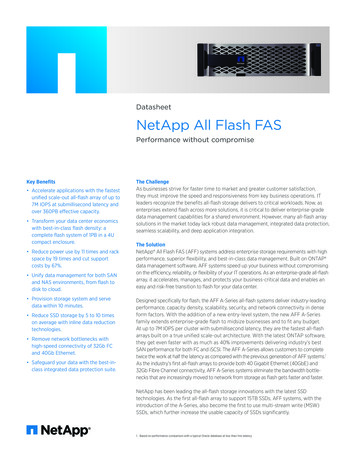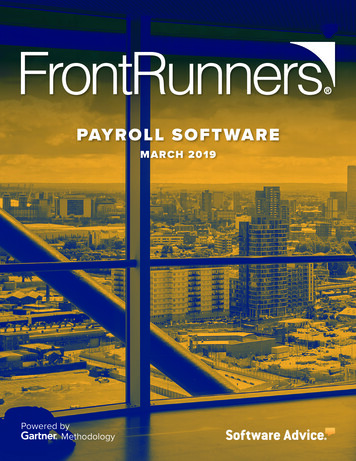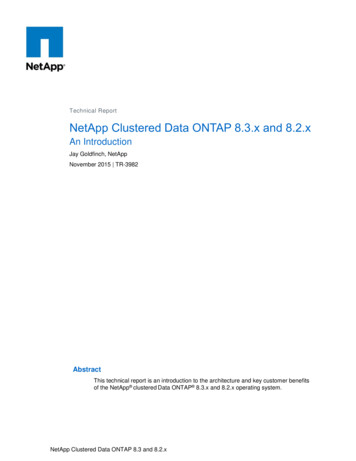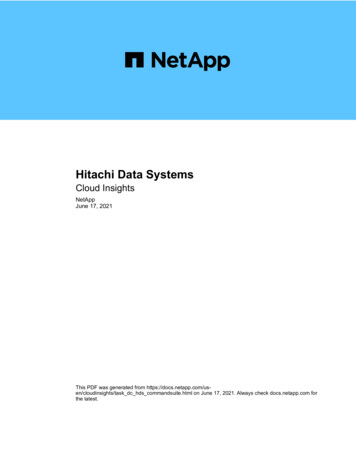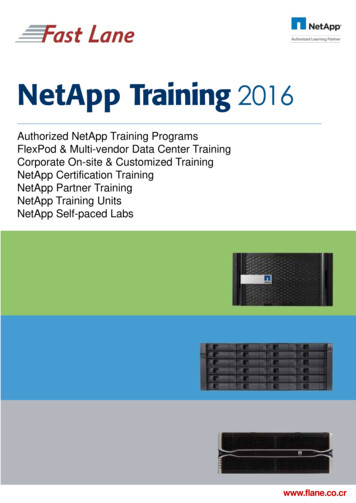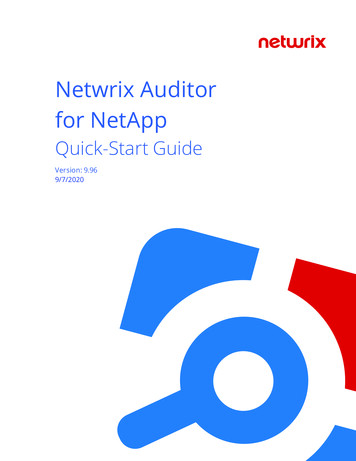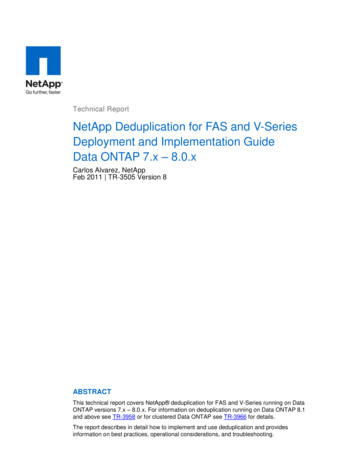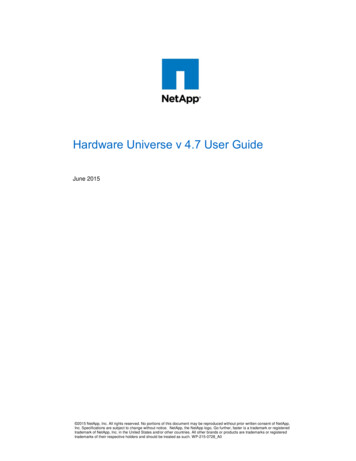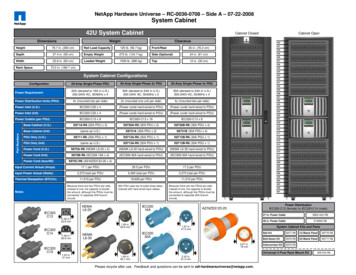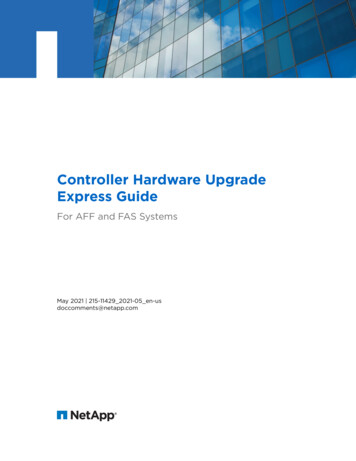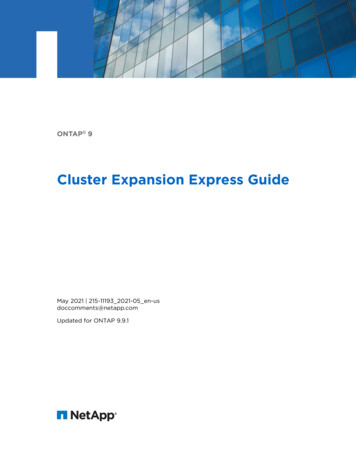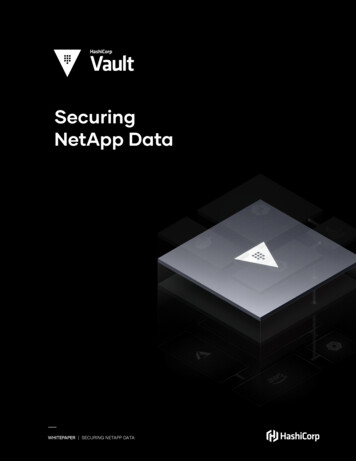
Transcription
SecuringNetApp DataWHITEPAPER SECURING NETAPP DATA1
ContentsIntroduction.3Key Management Interoperability Protocol (KMIP) .3Challenge.3Solution.4Securing NetApp Data with HashiCorp Vault.5NetApp Encryption .5Vault as an External Key Manager for NetApp.5Summary.7Additional Resources.7Advanced Data Protection with Vault.8Additional Resources.9WHITEPAPER SECURING NETAPP DATA2
IntroductionVault allows you to secure, store and tightly control access to tokens, passwords, certificates,encryption keys, and other sensitive data using a UI, CLI, or HTTP API. Vault recently completedNetApp product interoperability validation against ONTAP 9.7, 9.6, and 9.3 to satisfy ourcustomers requirements for certified solutions when using Vault and NetApp.You can increase productivity, control costs by reducing systems, licenses and overhead bycentrally managing all secrets operations. Vault can also assist with reducing the risk of breachby eliminating static, hard-coded credentials by centralizing secrets. Identity Brokering for authentication and access to different clouds, policy enforcement,and easy automation. Single Workflow that integrates with existing infrastructure, reduces costs, and provides aunified audit trail. Open & Extensible strong open source community, large partner ecosystem, and fullfeatured multi-cloud secrets engines.Key Management Interoperability Protocol (KMIP)ChallengeOrganizations store sensitive, personal and valuable data, which must be protected. Leakage ofsuch data can lead to financial loss, reputational damage, legal ramifications and more. Thereare often requirements to comply with data protection standards and regulations like the PCIDSS, GDPR, HIPAA, etc.The OASIS Key Management Interoperability Protocol (KMIP) standard is a widely adoptedprotocol for handling cryptographic workloads and secrets management for enterpriseinfrastructure such as databases, network storage, and virtual/physical servers.WHITEPAPER SECURING NETAPP DATA3
When an organization has services and applications that need to perform cryptographicoperations (e.g. transparent database encryption, full disk encryption, etc), it often delegates thekey management task to an external provider via KMIP protocol. As a result, your organizationmay have existing services or applications that implement KMIP or use wrapper clients withlibraries/drivers that implement KMIP. This makes it difficult for an organization to adopt theVault API in place of KMIP.SolutionVault Enterprise v1.2 introduced the KMIP secrets engine which allows Vault to act as a KMIPserver for clients that retrieve cryptographic keys for encrypting data via KMIP protocol.Figure 1: High Level Client Server Architecture OverviewVault’s KMIP secrets engine manages its own listener to service KMIP requests which operateon KMIP managed objects. Vault policies do not come into play during these KMIP requests. TheKMIP secrets engine determines the set of KMIP operations the clients are allowed to performbased on the roles that are applied to a TLS client certificate.This enables existing systems to continue using the KMIP APIs instead of Vault APIs.WHITEPAPER SECURING NETAPP DATA4
Securing NetApp Data with HashiCorp VaultNetApp EncryptionNetApp offers state of the art secure data management, file-shares, backup, recovery,replication and disaster recovery solutions to a large number of enterprises all around the globe.The NetApp ONTAP system, which is one of the most popular storage operating systems in theworld, offers FIPS compliant encryption technology that also supports the OASIS KMIP protocol.NetApp Storage Encryption (NSE) is NetApp’s implementation of Full Disk Encryption whileNetApp Volume Encryption (NVE) and NetApp Aggregate Encryption (NAE) are softwarebased, data-at-rest encryption solutions, available in NetApp ONTAP based systems. AlthoughNetApp does offer an onboard key manager, most enterprises must use an external keymanager for compliance reasons as the keys must be stored outside of the storage system.Vault as an External Key Manager for NetAppHashiCorp Vault is the de-facto standard for managing secrets in multi-cloud and hybridenterprise environments. It is a simple, modern, scalable and highly automatable solution formanagement of all kinds of sensitive and secret data including passwords, keys, certificates, andencryption keys. One of the latest enterprise capabilities of Vault is a KMIP Secrets Engine whichis the best solution for external key manager requirements for enterprise storage systems likeNetApp ONTAP. Moreover, Vault can be integrated with an HSM for master key wrapping andauto unsealing.As mentioned earlier, Vault recently completed NetApp product interoperability validationagainst ONTAP 9.7, 9.6, and 9.3 to satisfy our customers requirements for certified solutionswhen using Vault and NetApp. See NetApp’s Interoperability Matrix Tool (IMT) for the latestvalidations of Vault with NetApp.WHITEPAPER SECURING NETAPP DATA5
Figure 2: How NetApp works with HashiCorp VaultNote: the KMIP and HSM features are Vault Enterprise features. Certified: Vault is validated, supported and certified for use by NetApp. Vault complies withthe OASIS KMIP standard. Secure Multi-tenancy: Isolate different tenant environments for security and compliance.Different teams and departments can work independently of each other and have access toonly their own keys and systems. HSM Support: Vault supports integration with any HSM that supports PKCS #11. Mosthardware-based KMIP Servers only support specific HSMs. Flexibility: Most key managers are hardware devices and difficult to procure, manage andmaintain. Vault gives you more flexibility as it is distributed as a binary and can be deployedon multiple Platforms.WHITEPAPER SECURING NETAPP DATA6
Cost and Efficiency: One deployment of Vault can create multiple independent KMIPservers. Save time and cost as you don’t need to buy and manage hardware devices foreach department. Management: Vault is easy to manage and use, as it offers Web UI, CLI, and HTTP APIinterfaces. High Availability: Built-in High Availability using Consul as the storage back-end. UsingConsul also provides automated registration, tagging, and health checks for Vault serviceswithin Consul. Disaster Recovery: Built-in multi-datacenter replication for horizontal scalability anddisaster recovery use-cases. Audit Logging: With Vault’s audit log, monitoring secret access across multipleenvironments and clouds is easy and automated. Future-proof: Vault comes power packed with multiple integrations like AWS, Azure,GCP, Kubernetes, Databases, and more. One Central service for secret and certificatemanagement, cryptographic and advanced data protection needs.SummaryWhen using HashiCorp Vault Enterprise as an external key manager for NetApp Encryption,organizations can save money, time, and resources. Vault is fully software-based andscalable and offers multiple integrations including for public clouds. It offers great automationcapabilities which reduce risks.Additional Resources Securing NetApp Data: A HashiCorp Vault KMIP Story KMIP Secrets Engine Learn - KMIP Secrets EngineWHITEPAPER SECURING NETAPP DATA7
Advanced Data Protection with VaultAdvanced Data Protection (ADP) is a module for Vault Enterprise focused on Enterprise-gradeData Protection and Encryption.Advanced Data Protection includes: KMIP Integration: The KMIP secrets engine allows Vault to act as a Key ManagementInteroperability Protocol (KMIP) server provider and handle the lifecycle of its KMIPmanaged objects. KMIP is a standardized protocol that allows services and applicationsto perform cryptographic operations without having to manage cryptographic material,otherwise known as managed objects, by delegating its storage and lifecycle to a keymanagement server.Figure 3: Advanced Data Protection with VaultWHITEPAPER SECURING NETAPP DATA8
Transform: The Transform secrets engine handles secure data transformation andtokenization against provided input value. Transformation methods may encompass NISTvetted cryptographic standards such as format-preserving encryption (FPE) via FF3-1,but can also be pseudonymous transformations of the data through other means, such asmasking.Figure 4: Transform Secret Engine OverviewAdditional Resources Introducing the KMIP Server Secret Engine Vault Transform: Protecting Secrets in External Systems Learn: Using KMIP to Secure MongoDB and MySQL Learn: Secure Data Transformation Using Format Preserving EncryptionWHITEPAPER SECURING NETAPP DATA9
NetApp Encryption NetApp offers state of the art secure data management, file-shares, backup, recovery, replication and disaster recovery solutions to a large number of enterprises all around the globe. The NetApp ONTAP system, which is one of the most
